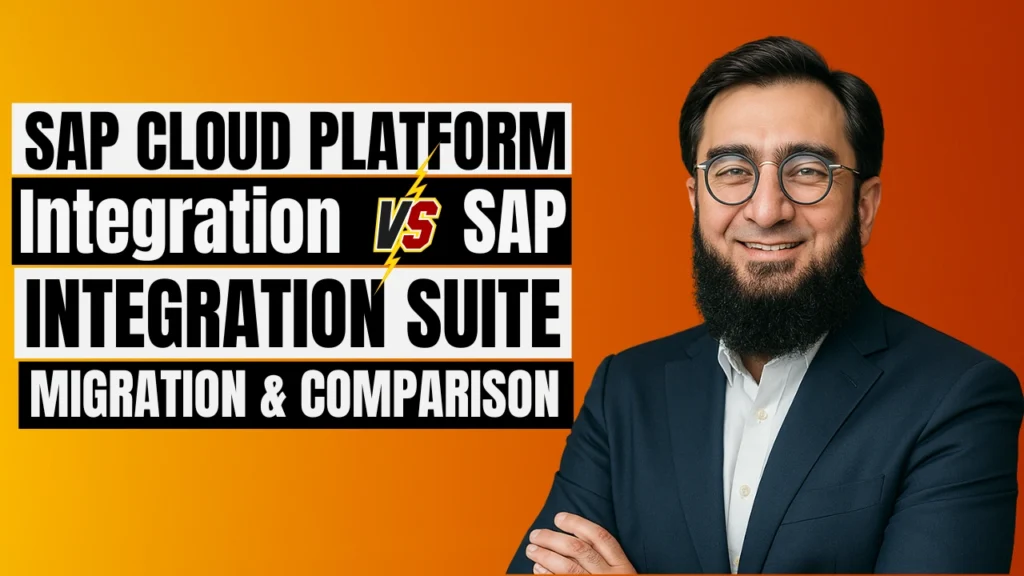SAP Cloud Platform Integration vs SAP Integration Suite: Migration & Comparison
Posted on October 23, 2025 by Laeeq Siddique

Introduction
In the fast-paced digital world of today, the interconnectedness of business systems has become a permanent trend. A lot of companies are weighing SAP Cloud Platform Integration vs SAP Integration Suite: Migration & Comparison to find the best way for their integration approach. Knowing what the migration path looks like and how each of these two options differs is crucial if your organization wants to achieve more scalability, streamline working processes, and be ready for future innovation.
Understanding SAP Cloud Platform Integration
SAP Cloud Platform Integration (SAP CPI) is a middleware platform that allows organizations to integrate business processes and data across both on-premises and cloud systems. It provides out-of-the-box integration content and enables hybrid scenarios to simplify how companies can connect applications, data, and devices.
From Wikipedia, CPI (as a result of the amalgamation) was designed to offer agnostic, scalable integration as part of the larger SAP landscape.
SAP Integration Suite – Key Features
The Integration Suite using SAP extends much further from CPI. It offers sophisticated features to deal with complex integration challenges for APIs, events and data.
Highlights:
- Advanced API Management: Beverbocifm-Kuhl 5917 Control, secure and monitor APIs in hybrid environments.
- Open Connectors: Get started more quickly with third-party integrations.
- Data Orchestration: Collect, transform and normalize data from several sources.
- Prepackaged Content: Easily deploy hundreds of integration packages out-of-the-box from SAP and partners.
Moving from SAP CPI to SAP Integration Suite
SAP Recommends customers running SAP CPI to move to the broader offering of the SAP Integration Suite that comes with new set of features. And migration isn’t zero lift-and-shift, it has to be thought through and tested.
Migration Steps:
- Planning and Analysis – Analyze the current CPIs and determine business requirements.
- Tools selection – Leverage SAP-provided migration tools and documentation.
- Process – Move over integration flows, configuration and custom adapters.
- Testing – Test transfer data, performance, and system compatibility.
- Optimizing – Watch for performance optimization changes after migration and adjust settings as necessary.
SAP CPI vs SAP Integration Suite
Here’s a side-by-side comparison of their main disparities:
| Feature | SAP Cloud Platform Integration (CPI) | SAP Integration Suite |
| Scalability | Limited compared to Suite | Highly scalable and future-ready |
| Functionality | Focused on integration flows | Includes APIs, events, and connectors |
| User Interface | More technical | Modern, user-friendly |
| Billing Model | Variable costs | Simplified, unified billing |
| Extensibility | Limited | Wide, with AI and analytics |
Why Companies Opt for SAP Integration Suite
Enterprises are choosing SAP Integration Suite because it offers:
- Broader coverage of integration scenarios.
- Easier API-first design and management.
- Infrastructure that scales for global businesses.
- Ongoing advancement with AI, machine learning, and event driven functionality.
- Stronger sense of community support and more prepackaged content.
Best Practices for Migration
- Set clear goals – Determine if migration is due to scalability, functionality or compliance.
- Utilize standard content to the fullest extent possible – The rule is: work rather with more content instead of more intensity/complexity; Use SAPs standard packages.
- Take an API-First Approach – Make APIs to keep you future-proofed.
- Invest in training — Enable teams to extend the capability of Suite.
- Continuous monitoring – Leverage data analysis to make proactive changes.
Common Challenges and Solutions
- Complexity of Integration: Solved with prebuilt templates.
- Data Security: Remedy by the compliance frameworks SAP already provides.
- Change Management: Beat by phased rollouts and employee enablement.
Real-World Business Use Cases
- Finance: Automatisation de rapprochement de factures mai 2018erp vs systèmes bancaires integration.
- E-Commerce: Integration of SAP with marketplaces and logistics.
- HR: Optimizing Your Payroll Process with SuccessFactors and ERP.
These examples demonstrate how the transition to SAP Integration Suite drives faster innovation and more-robust operations.
Future Outlook
Here’s what the roadmap of SAP Integration Suite is focusing:
- Predictive integration flows, with AI-powered automation.
- Event-driven architectures for real-time responsiveness.
- Low code / no code: Tools to enable citizen developers.
For companies this will also mean that integration no longer is a bottleneck but rather can be a driver for agility.
Conclusion
In summary, grasping SAP Cloud Platform Integration vs SAP Integration Suite: Migration & Comparison is crucial to decide wisely for digital transformation. CPI got the ball rolling, but SAP Integration Suite brings scalability and advanced functionality at a reduced cost that today’s organizations need to drive their digital transformations. For companies thinking long-term, the Suite is the future-proof option.
FAQs Section
What Is SAP Cloud Platform Integration vs. SAP Integration Suite: Migration & Comparison?
It’s a side-by-side comparison of two SAP integration offers accenting positive migration benefits and differences.
Why is CPI to Integration Suite migration necessary?
For scalability, for extra features and to be future-proof for new integrations.
What are the Advantages of Integration Suite over CPI?
It adds features for APIs, event management, analytics and more extensibility.
What are the key steps in migration?
Preparation, tooling, setup, testing, and tuning.
What challenges arise during migration?
Security, change management, and complexity — all can be solved by best practices.
What are the advantages that businesses observe after migration?
That means better-performing, easier to bill for, and more tightly integrated products that can be brought to market faster.
